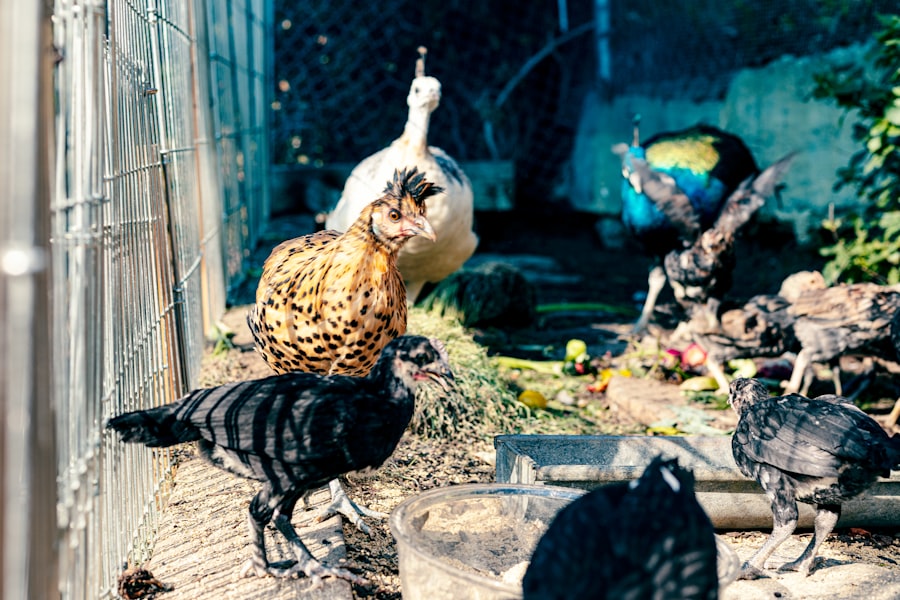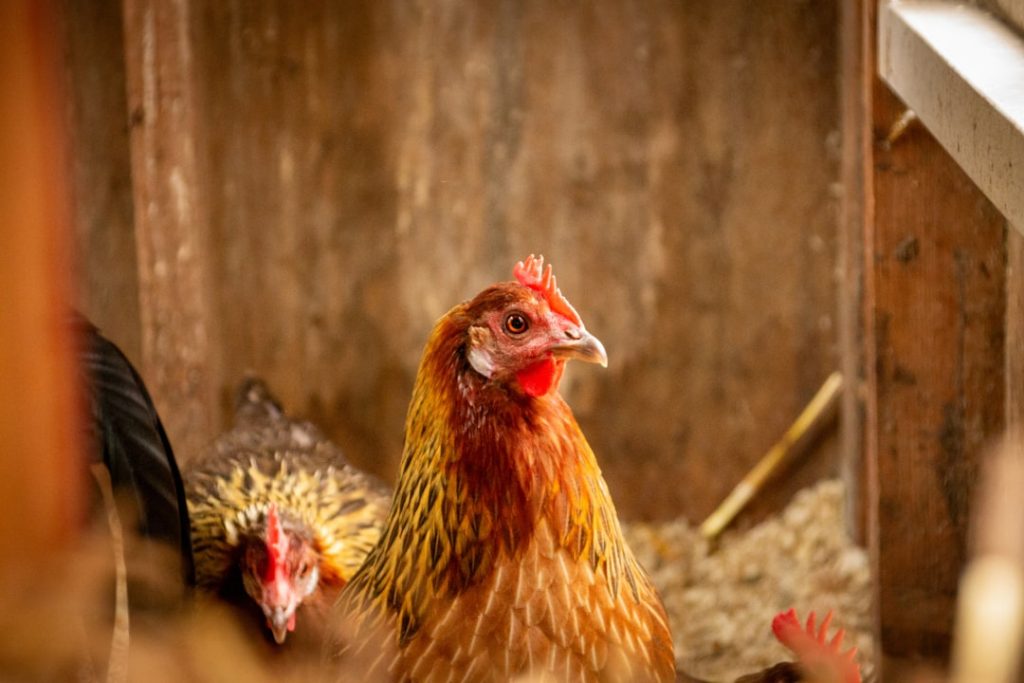When it comes to keeping chickens, providing adequate space is crucial for their health and well-being. Chickens are social animals that require space to move around, exercise, and exhibit natural behaviors such as scratching, dust bathing, and foraging. The amount of space needed for chickens depends on various factors such as the breed, age, and purpose of keeping them.
Understanding the space requirements for keeping chickens is essential for creating a comfortable and healthy environment for your flock. Chickens need space to roam and explore, as well as access to fresh air and sunlight. The amount of space required per chicken can vary depending on the breed and purpose of keeping them.
For example, larger breeds such as Orpingtons or Brahmas will require more space compared to smaller breeds like bantams. Additionally, the purpose of keeping chickens, whether for egg production, meat, or as pets, will also influence the space requirements. It’s important to consider these factors when determining the appropriate space for your flock to ensure their well-being and productivity.
Table of Contents
- 1 Factors to consider when determining space for chickens
- 2 Minimum space requirements for different chicken breeds
- 3 The importance of providing adequate space for chickens
- 4 Tips for maximizing space in a small backyard or urban setting
- 5 Potential problems of not providing enough space for chickens
- 6 Creating a comfortable and spacious environment for your chickens
- 7 FAQs
- 7.1 What is the minimum space requirement for keeping chickens?
- 7.2 What factors should be considered when determining the space needed for chickens?
- 7.3 How does the breed of the chickens affect the space requirement?
- 7.4 What are the benefits of providing adequate space for chickens?
- 7.5 Can chickens be kept in a small backyard?
- 7.6 What are the consequences of not providing enough space for chickens?
Key Takeaways
- Understanding the space requirements for keeping chickens:
- Chickens require adequate space to roam, forage, and exercise to maintain their health and well-being.
- Factors to consider when determining space for chickens:
- Consider the number of chickens, their breed, and the available space in your backyard or urban setting.
- Minimum space requirements for different chicken breeds:
- Different chicken breeds have varying space requirements, with larger breeds needing more space than smaller ones.
- The importance of providing adequate space for chickens:
- Adequate space promotes good health, reduces stress, and minimizes aggressive behavior among chickens.
- Tips for maximizing space in a small backyard or urban setting:
- Utilize vertical space, consider portable coops, and incorporate space-saving features like hanging feeders and waterers.
- Potential problems of not providing enough space for chickens:
- Overcrowding can lead to health issues, increased aggression, and a decline in egg production.
- Creating a comfortable and spacious environment for your chickens:
- Provide ample space for roaming, dust bathing areas, perches, and shelter from the elements to ensure a comfortable and spacious environment for your chickens.
Factors to consider when determining space for chickens
Calculating Space Needs
When determining the space requirements for chickens, there are several factors to consider to ensure that your flock has enough room to thrive. The size of the coop and the outdoor run, as well as the number of chickens in the flock, are important considerations when calculating the space needed. The general rule of thumb is to provide at least 2-3 square feet of coop space per chicken and 8-10 square feet of outdoor run space per chicken.
Factors Affecting Space Requirements
However, these numbers can vary depending on the breed and size of the chickens. In addition to the physical space, it’s important to consider the layout and design of the coop and run to maximize the available space. Providing perches, nesting boxes, and enrichment activities such as dust bathing areas and foraging opportunities can help make the most of the space available.
Climate and Weather Considerations
It’s also important to consider the climate and weather conditions in your area when designing the coop and run to ensure that your chickens have adequate protection from the elements.
Creating a Comfortable Environment
By taking these factors into account, you can create a comfortable and spacious environment for your flock to thrive.
Minimum space requirements for different chicken breeds

Different chicken breeds have varying space requirements based on their size, activity level, and natural behaviors. Larger breeds such as Plymouth Rocks or Wyandottes will require more space compared to smaller breeds like Silkies or Polish chickens. Bantam breeds, which are miniature versions of standard breeds, will also require less space due to their smaller size.
When determining the minimum space requirements for different chicken breeds, it’s important to consider their size, activity level, and social dynamics within the flock. For larger breeds, it’s recommended to provide at least 4 square feet of coop space per chicken and 10-12 square feet of outdoor run space per chicken. Smaller breeds may require less space, with a minimum of 2-3 square feet of coop space per chicken and 6-8 square feet of outdoor run space per chicken.
It’s important to keep in mind that these are minimum requirements, and providing more space whenever possible is always beneficial for the well-being of your flock. By understanding the specific space requirements for different chicken breeds, you can ensure that your flock has enough room to thrive and exhibit natural behaviors.
The importance of providing adequate space for chickens
Providing adequate space for chickens is essential for their physical and mental well-being. Chickens that are confined in small or overcrowded spaces are more likely to exhibit stress-related behaviors such as feather picking, aggression, and reduced egg production. Inadequate space can also lead to health issues such as respiratory problems and increased risk of disease transmission within the flock.
By providing enough space for chickens to move around, exercise, and exhibit natural behaviors, you can help reduce stress and promote overall health and productivity. In addition to physical health, providing adequate space is also important for the mental well-being of chickens. Chickens are social animals that thrive in environments where they can establish a pecking order, form social bonds, and engage in natural behaviors such as dust bathing and foraging.
When chickens have enough space to roam and explore, they are less likely to exhibit negative behaviors such as aggression or boredom-related vices. By creating a spacious and enriching environment for your flock, you can help promote their overall well-being and happiness.
Tips for maximizing space in a small backyard or urban setting
In small backyard or urban settings, maximizing space for keeping chickens can be a challenge. However, with some creative planning and design, it’s possible to create a comfortable and spacious environment for your flock. One way to maximize space is by utilizing vertical space in the coop and run.
Installing roosts at different levels and using hanging feeders and waterers can help free up floor space and provide more room for chickens to move around. Another tip for maximizing space is to create a multi-functional outdoor run that serves as both a grazing area and a dust bathing zone. By incorporating raised garden beds or mobile grazing frames within the run, you can provide your chickens with access to fresh greens while also allowing them to engage in natural behaviors such as scratching and dust bathing.
Additionally, using portable chicken tractors or rotational grazing systems can help maximize outdoor space by allowing your flock to access fresh pasture while minimizing impact on the land.
Potential problems of not providing enough space for chickens

Physical Health Consequences
Inadequate space can also lead to poor air quality within the coop, increasing the risk of respiratory problems and disease transmission within the flock. This can have serious consequences for the health of your chickens, making them more susceptible to illness and disease.
Mental Health Impacts
In addition to physical health issues, not providing enough space can also impact the mental well-being of chickens. Boredom and frustration from lack of space can lead to negative behaviors such as feather picking and aggression. Chickens may also become more susceptible to stress-related illnesses and have a reduced quality of life when confined in small or overcrowded spaces.
The Consequences of Inadequate Space
By not providing enough space for chickens, you are putting their health and well-being at risk, which can ultimately impact their productivity and longevity. It is essential to ensure that your chickens have enough space to move around comfortably and engage in natural behaviors to maintain their overall health and well-being.
Creating a comfortable and spacious environment for your chickens
Creating a comfortable and spacious environment for your chickens is essential for their overall health and well-being. Start by providing a well-designed coop that offers enough room for roosting, nesting, and perching. The coop should also have good ventilation to ensure proper air circulation and reduce moisture buildup.
In addition to the coop, it’s important to provide a spacious outdoor run that allows your flock to roam, explore, and engage in natural behaviors. To create a comfortable environment, consider adding enriching elements such as perches, dust bathing areas, and hanging toys or treats within the coop and run. Providing access to fresh greens and opportunities for foraging can also help keep your chickens mentally stimulated and physically active.
Regularly cleaning and maintaining the coop and run will help ensure a clean and healthy environment for your flock. By creating a comfortable and spacious environment for your chickens, you can help promote their overall well-being and happiness. In conclusion, understanding the space requirements for keeping chickens is essential for creating a healthy and comfortable environment for your flock.
By considering factors such as breed, age, purpose of keeping chickens, and maximizing available space in small backyard or urban settings, you can ensure that your flock has enough room to thrive. Providing adequate space is crucial for promoting the physical and mental well-being of chickens while reducing the risk of potential problems associated with overcrowding. By creating a comfortable and spacious environment for your chickens, you can help ensure that they lead happy and healthy lives.
If you’re considering keeping chickens, you may be wondering how much space you need for a coop. According to a helpful article on Poultry Wizard, the size of the coop depends on the number of chickens you plan to keep. The article provides detailed information on the space requirements for different flock sizes, as well as tips for converting a shed into a chicken coop and even renting a chicken coop. For more information, you can check out the article here.
FAQs
What is the minimum space requirement for keeping chickens?
The minimum space requirement for keeping chickens is 2-3 square feet per bird inside the coop and 8-10 square feet per bird in an outdoor run.
What factors should be considered when determining the space needed for chickens?
Factors to consider when determining the space needed for chickens include the breed of the chickens, the size of the coop and outdoor run, and the amount of time the chickens will spend outside.
How does the breed of the chickens affect the space requirement?
Different breeds of chickens have different space requirements. Larger breeds will need more space compared to smaller breeds. It’s important to research the specific space needs of the breed you plan to keep.
What are the benefits of providing adequate space for chickens?
Providing adequate space for chickens allows them to exhibit natural behaviors such as scratching, dust bathing, and foraging. It also helps to reduce stress and aggression within the flock.
Can chickens be kept in a small backyard?
Chickens can be kept in a small backyard as long as the space is utilized efficiently. Consider using vertical space for roosting and providing a secure outdoor run for them to roam.
What are the consequences of not providing enough space for chickens?
Not providing enough space for chickens can lead to stress, aggression, and health issues within the flock. It can also result in unsanitary living conditions and a decrease in egg production.
Meet Walter, the feathered-friend fanatic of Florida! Nestled in the sunshine state, Walter struts through life with his feathered companions, clucking his way to happiness. With a coop that’s fancier than a five-star hotel, he’s the Don Juan of the chicken world. When he’s not teaching his hens to do the cha-cha, you’ll find him in a heated debate with his prized rooster, Sir Clucks-a-Lot. Walter’s poultry passion is no yolk; he’s the sunny-side-up guy you never knew you needed in your flock of friends!







